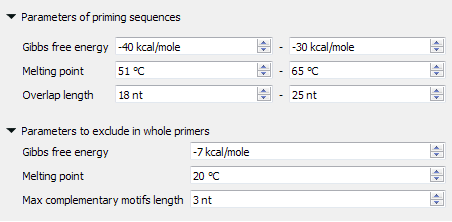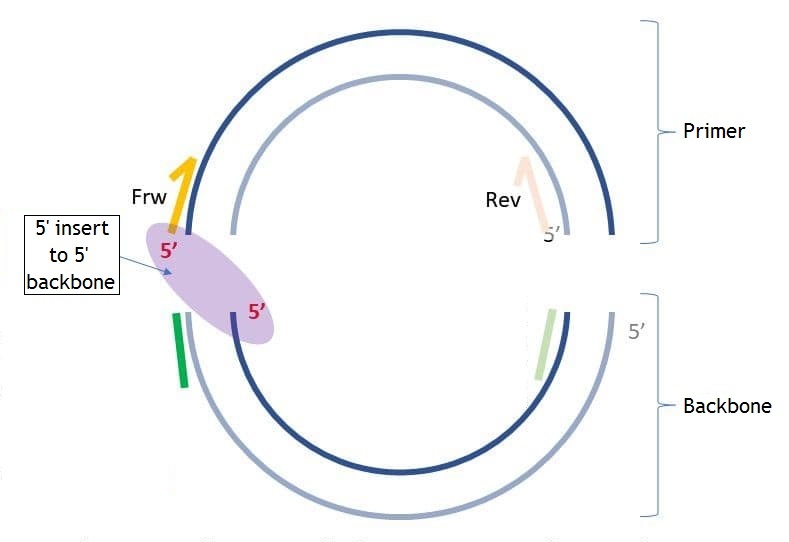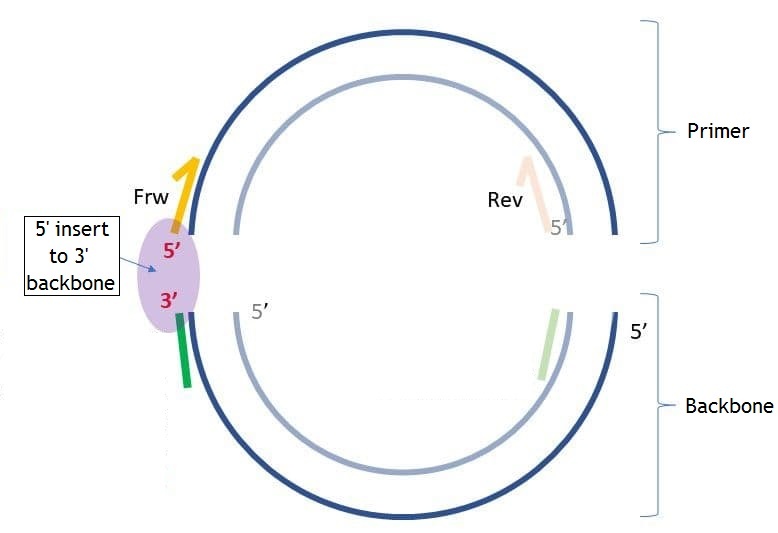
The polymerase chain reaction (PCR) uses a pair of custom primers to direct DNA elongation toward each other at opposite ends of the sequence being amplified. These primers are typically between 18 and 24 bases in length and must code for only the specific upstream and downstream sites of the sequence being amplified. A primer that can bind to multiple regions along the DNA will amplify them all, eliminating the purpose of PCR.
A few criteria must be brought into consideration when designing a pair of PCR primers. Pairs of primers should have similar melting temperatures since annealing during PCR occurs for both strands simultaneously, and this shared melting temperature must not be either too much higher or lower than the reaction's annealing temperature. A primer with a Tm (melting temperature) too much higher than the reaction's annealing temperature may mishybridize and extend at an incorrect location along the DNA sequence. A Tm significantly lower than the annealing temperature may fail to anneal and extend at all.
Additionally, primer sequences need to be chosen to uniquely select for a region of DNA, avoiding the possibility of hybridization to a similar sequence nearby.
Also, there are other parameters to be taken in account - Gibbs free energy, self- and heterodimers availability, etc. All parameters are described below in details.
UGENE provides the "PCR Primer Design for DNA Assembly" feature only for nucleic sequences with the "Standard DNA" alphabet. To use it in UGENE open a DNA sequence and go to the "PCR Primer Design for DNA Assembly" tab of the Options Panel:

There are the following parameters:
The designed primers should have the set Gibbs free energy, melting temperature and length. Also, these primers could have hairpins, self- and hetero-dimers, but the mentioned parameters of these found dimers should be limited. Look at the pictures:


The found primer "GATGGTGATGTTAATGGGCAC" has Gibbs free energy between -40 and -30 kcal/mol, melting temperature between 51 and 65 °C and length between 18 and 25 nucleotides. Also, there are no heirpins, self- and hetero-dimers in this primer, which has Gibbs free energy more then -7 kcal/mol, melting temperature less than 20 °C and base pairs length more than 3 nucleotides.
Forward primers are searched at the left region, reverse primers are searched at the right region. There is an amplified fragment between them:

The left search area is from 1 to 71 base, the right search area is from 355 to 426 base. The amplified fragment between them.
Backbone sequence is the sequence that is added to 5' end of the primer for the following assembly of the PCR product with the backbone molecule. This parameter is optional. You may set the backbone sequence, the sequence end you want to add backbone to and the length of the sequence from 5' and 3' ends to check if these sequences have unwanted hairpins, self- and hetero-dimers. On the pictures below you may see the differences between "5' insert to 5' backbone" and "5' insert to 3' backbone" ("insert" in this case is the same as "primer").


If you set "5' backbone length", then the number of bases you set from 5' end of the backbone sequence will be checked for unwanted connections. The same about "3' backbone length", but from the 3' end. If the checked end has hairpins, self- and homo-dimers you will see the following dialog:
Type two primers for running In Silico PCR. If the primers pair is invalid for running the PCR process then the warning is shown. Also, primers for the running In silico PCR can be chosen from a primer library. Click the following button to choose a primer from the primers library:
<center> <br> <img src="/wiki/download/attachments/13435073/Primers Library.png"/> </br> </center> |
The following dialog will appear:
<center> <br> <img src="/wiki/download/attachments/16125631/In Silico PCR_2.png"/> </br> </center> |
The table consists of the following columns: name, GC-content (%), Tm, Length (bp) and sequence. Select primer in the table and click the Choose button.
Click the Reverse-complement button for making a primer sequence reverse-complement:
<center> <br> <img src="/wiki/download/attachments/13435069/In Silico PCR_1.png"/> </br> </center> |
Click Show primers details for seeing statistic details about primers.
When you run the process, the predicted PCR products appear in the products table.
There are three columns in the table:
Click the product for navigating to its region in the sequence.
Click the Extract product(s) button for exporting a product(s) in a file or use double click for that.
<center> <br> <img src="/wiki/download/attachments/13435069/In Silico PCR_2.png"/> </br> </center> |